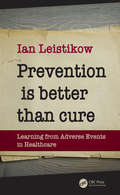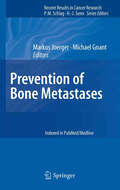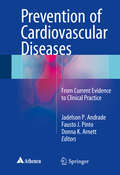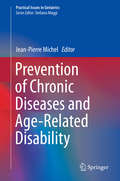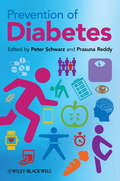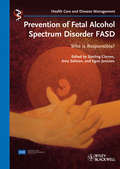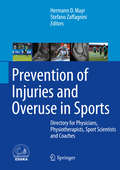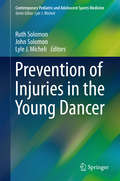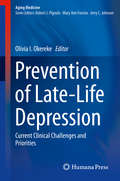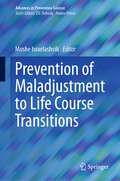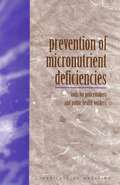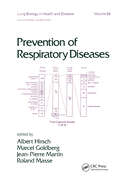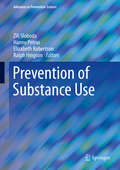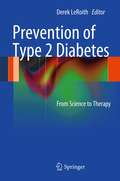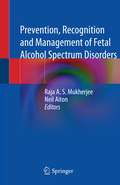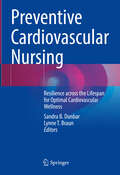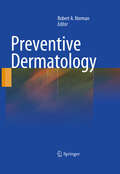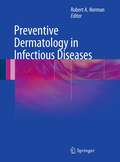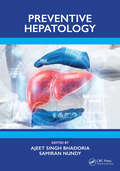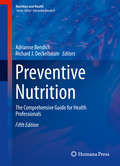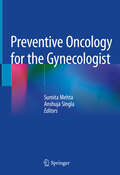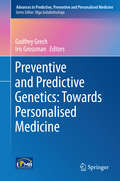- Table View
- List View
Prevention is Better than Cure: Learning from Adverse Events in Healthcare
by Ian LeistikowAdverse events occur in healthcare with worrying and surprising frequency and, of these, a substantial portion are preventable. This highly-readable book, translated and update from the original Dutch edition, presents 15 model case studies which have been carefully designed to explore common themes in medical errors and offer learnings from those events that will guide practice to prevent similar tragedies unfolding in future. Using 15 years of experience working in patient safety, the author makes concrete recommendations around assessment, attitude and performance, and provides a concise and accessible methodology for working safely.
Prevention of Bone Metastases
by Markus Joerger Michael GnantBone metastases continue to be a major cause of morbidity in cancer patients, but improved understanding of the biology of bone metastases has led to the identification of drugs that are of potential value in not only their treatment but also their prevention. This book, written by recognized experts in the field, provides a detailed overview of current knowledge on this subject. One important focus of the book is the efficacy of bisphosphonates in preventing bone metastases in patients with breast, lung, and prostate cancer and disease progression in cases of multiple myeloma. The combined use of bisphosphonates and cytostatics is also discussed, with a report on first clinical data. Further topics addressed include the significance of the bone microenvironment, special issues in the elderly patient, the use of bone turnover markers, and initial findings obtained with denosumab.
Prevention of Cardiovascular Diseases
by Jadelson P. Andrade Fausto J. Pinto Donna K. ArnettThe present book reveals the importance of preventive medicine in cardiology and public health, addressing the lack of a broad discussion of this topic in the current literature. It examines the most important risk factors for different cardiovascular diseases, discussing them in detail from a clinical standpoint and presenting important information from a preventive medicine perspective. Further, specific chapters discuss the burden of cardiologic risk factors in special contexts, such as in women, child and adolescents, and in low-income populations. Lastly, a number of conditions that are often overlooked in terms of their cardiological impact are discussed, such as Chagas disease, rheumatic cardiomyopathy and post-traumatic stress disorder. Cardiovascular diseases are still the major cause of death in the world, even though they are considered preventable clinical conditions. The increased prevalence of some risk factors for cardiovascular diseases is an important concern for cardiologists around the world. On the other hand, primary prevention programs have proven their efficacy concerning some known and treatable risk factors, such as with hypercholesterolemia, hypertension, diabetes and smoking, but still need to be made more of a priority in public health. Prevention of Cardiovascular Diseases is a book intended for multi-disciplinary audience and aimed for all professionals who are willing to face the challenge of cardiovascular prevention
Prevention of Chronic Diseases and Age-Related Disability (Practical Issues in Geriatrics)
by Jean-Pierre MichelThis book explains how to promote and prolong “healthy ageing,” which constitutes maintaining daily functioning and well-being until the end of life. In this context, the editor of the book and the international team of authors, all of whom are experts on the various aspects of ageing, demonstrate the value of this new approach in clinical practice. The systematic integration of a functional assessment, if not a complete and comprehensive geriatric assessment, is fundamental in daily clinical practice. Identifying risk factors at midlife will help to promote health at any age. Moreover, randomized control trials are making it increasingly clear that interventions could help ageing and elderly adults enjoy their remaining years without disability. Indeed, wellbeing will also increase, allowing elderly adults to stay independent until a very advanced age. The book also shows how considerable societal benefits can be easily forecast when more lifetime is spent without benefits, followed by a dignified end of life. This book will be of interest to all medical doctors, general practitioners and organ specialists as well as geriatricians who want to have a complete overview of what healthy ageing means.
Prevention of Diabetes
by Prasuna Reddy Peter SchwarzExpertly authored by the world's leading specialists in the field, Prevention of Diabetes is the definitive guide for better preventative diabetes care. Using an evidence-based approach, it outlines the very latest in the identification of people at high risk for type 2 diabetes and how best to use interventional methods such as screening at-risk individuals, pharmaceutical intervention and lifestyle changes. In addition, it will provide healthcare professionals with the clinical knowledge required to clearly identify the early symptoms of diabetes, enabling them to provide their patients with better clinical care and helping avoid the onset of full-blown diabetes.Also covered are both the health economics of establishing, and the methods of implement/delivering targeted prevention programmes into clinical and health care practice, based on the vast experience of the editors due to their involvement in such programmes.Prevention of Diabetes provides clear and expert information in a practical, accessible way, and is ideal reading for all those with an interest in the prevention of diabetes and obesity, such as public health workers, specialists in diabetes and obesity, and GP's seeing patients with early onset or pre-diabetes symptoms.
Prevention of Fetal Alcohol Spectrum Disorder FASD: Who is responsible? (Health Care and Disease Management #14)
by Egon Jonsson Sterling Clarren Amy SalmonExposing a developing embryo or fetus to alcohol can produce life long brain damage with neurological, cognitive and behavioural consequences. The implications of fetal alcohol spectrum disorder for the affected individual and the family are devastating. The social and economic burden to society is enormous with formidable expenditures in health care, mental health care, education, social services and possibly correctional services. Prevention has been a goal since the condition was medically described and defined forty years ago, but has remained elusive but feasible. This book reviews the evidence for effective strategies. It lays out what needs to be done. The book should be of great value to policy makers, clinicians, researchers and others advocating for action against this condition that is reducing the potential of our society and sapping its resources.
Prevention of Injuries and Overuse in Sports
by Stefano Zaffagnini Hermann O. MayrThis book, published in cooperation with ESSKA, is a comprehensive, evidence-based manual on the prevention of injuries and overuse in sports that will assist physicians, physiotherapists, and trainers in providing excellent mental and physical guidance to athletes. The causes of overuse and sports injuries are carefully analyzed, explaining the medical basis for prevention. In addition, detailed attention is paid to the relationship between sport motivation, risk willingness, tendency to overload, and tendency to increased risk of injury. The reader is effectively trained in mental and physical analysis of the athlete and will gain an appreciation of the influence of the athlete's environment on susceptibility to injury. Gender-specific differences and the specific risks faced by children and adolescents are identified, and very popular sports such as soccer, alpine skiing, and throwing sports are discussed in individual chapters. Training schedules of value in the context of particular physiotherapeutic and medical interventions are described with the help of illustrations and charts. The authors are team physicians, coaches, sports scientists, training scientists, and physiotherapists involved in high-performance sports and recreational sports.
Prevention of Injuries in the Young Dancer
by Ruth Solomon John Solomon Lyle J. MicheliFocusing exclusively on injury treatment and prevention in the young dancer, this comprehensive text addresses the unique needs of these athletes and stresses how their bodies differ in significant ways from adults', requiring that their training and clinical management be overseen by specialized personnel. The book opens with a discussion of the epidemiology of injury in the young dancer, followed by a description of screening procedures and a sample screening program. Physical therapy and resistance training are then covered, along with common conditions and injuries at the spine, hip, knee, and foot and ankle complex. Additional chapters discuss the use of diagnostic and interventional ultrasound, nutrition and bone health, psychological issues such as anxiety, eating disorders and peer relationships, and lastly the prevention of degenerative hip injuries. Prevention of Injuries in the Young Dancer is an essential resource with regard to the physical and psychological challenges facing young performers. It is relevant reading for dance medicine, sports medicine, and orthopedic professionals, as well as dancers, their parents, and especially those persons who promote their careers.
Prevention of Intimate Partner Violence
by Sandra StithStop intimate partner violence before it startsIntimate partner violence touches everyone. With more than 1 million cases reported each year, this pervasive social problem has devastating effects on victims, families, and communities. Prevention of Intimate Partner Violence presents a comprehensive overview of the wide range of efforts and approaches that have been successful in preventing physical, emotional, and verbal abuse. A growing frustration with the limits of therapeutic intervention and with the costs imposed on society by intimate partner violence has created a need for greater emphasis on state-of-the-art prevention programs that really work. Prevention of Intimate Partner Violence addresses the challenges of conducting and evaluating such programs, gaps that exist in programming and research, and future trends in those areas. A panel of domestic violence experts, researchers, and healthcare professionals examines how to change the ways individuals and the current health care system think about, and respond to, intimate partner violence; how to change the ways young people deal with anger in intimate relationships; and the ways society can support families to reduce the occurrence of violence in intimate relationships. Prevention of Intimate Partner Violence examines: identifying risk factors the cost-benefit of universal and targeted programs the effectiveness of parenting, stress management, and substance abuse programs community capacity theory community development social networks media and public awareness campaigns healthcare screening programs and much morePrevention of Intimate Partner Violence documents the effectiveness of prevention interventions, encouraging prevention specialists to use evidence-based interventions to enhance the effectiveness of their own work. This powerful book is an invaluable professional resource for social workers, family life educators, researchers, and practitioners.
Prevention of Late-Life Depression
by Olivia I. OkerekeThis book illustrates the imperative for late-life depression prevention, introducing a broad range of approaches to prevention and provides detailed examples of clinical applications of late-life depression prevention - all with consideration of medical and scientific, social, economic and global health perspectives. Clear guidelines are delineated for assessing, treating and preventing such conditions as depression and anxiety, dementia, psychosis and mania, sleep disturbances and personality disorders. Written by experts in the field, this text considers the complicating conditions that depression may incur higher costs and create during the course and treatment of comorbid major medical conditions that are also highly prevalent in older adults - including diabetes, hypertension and heart disease. Prevention of Late-Life Depression: Current Clinical Challenges and Priorities is an important new volume that will be useful to all providers that are concerned with the mental health of our rapidly expanding aged population.
Prevention of Maladjustment to Life Course Transitions (Advances in Prevention Science)
by Moshe IsraelashviliThis book provides a comprehensive and updated review of the concepts, models, and interventions related to the process of adjustment to life course transitions. In times of transition, an individual is exposed to experiences that require them to assume new roles and exhibit updated behaviors. Regardless of the characteristics of these transitions, exposure to normative trajectories imposes on the person an intensive engagement in a process of (re-)adjustment. Sometimes this demand is beyond the scope of one's ability, motivation, or comprehension. Hence, some people might ineffectively perceive and/or react to the change and end up feeling unable to handle the change and inclined to escape the situation. A preventive intervention that either reduces the impact of possible risk factors or fosters possible protective factors would support the people in managing the transition. While the importance of prevention of maladjustment is repeatedly mentioned in the literature, this is the first-known book on how to prevent maladjustment. It examines how the sense of transition emerges, what adjustment means, the models that elaborate on how people manage in times of transition, what the antecedents of maladjustment are, and especially how maladjustment could be prevented. Out of these discussions, a new model, The Transitional Stress and Adjustment (TSA) Model, is suggested as a grand framework for paving a way forward to better prevent people's maladjustment to life course transitions. Prevention of Maladjustment to Life Course Transitions is a much-needed cornerstone in the future development within the prevention science framework. This book has interdisciplinary appeal for researchers, practitioners, and graduate students in psychology, sociology, public health, social work, criminology, medicine, health sciences, public policy, economics, and education who consider prevention an important vehicle of intervention to promote health and wellbeing. Its focus on the topic of adjustment also would be of special interest to those who explore child and youth development.
Prevention of Micronutrient Deficiencies: Tools for Policymakers and Public Health Workers
by Committee on Micronutrient DeficienciesMicronutrient malnutrition affects approximately 2 billion people worldwide. The adverse effects of micronutrient deficiencies are profound and include premature death, poor health, blindness, growth stunting, mental retardation, learning disabilities, and low work capacity. Preventing Micronutrient Deficiencies provides a conceptual framework based on past experience that will allow funders to tailor programs to existing regional/country capabilities and to incorporate within these programs the capacity to address multiple strategies (i.e., supplementation/fortification/food-based approaches/public health measures) and multiple micronutrient deficiencies.The book does not offer recommendations on how to alleviate specific micronutrient deficiencies--such recommendations are already available through the publications of diverse organizations, including the U.S. Agency for International Development, the Micronutrient Initiative, World Bank, United Nations Childrens' Fund, and the World Health Organization. Instead, this volume examines key elements in the design and implementation of micronutrient interventions, including such issues as:The importance of iron, vitamin A, and iodine to health. Populations at risk for micronutrient deficiency. Options for successful interventions and their cost. The feasibility of involving societal sectors in the planning and implementation of interventions. Characteristics of successful interventions.The book also contains three in-depth background papers that address the prevention of deficiencies of iron, vitamin A, and iodine.
Prevention of Respiratory Diseases (Lung Biology in Health and Disease)
by Jean-Pierre Martin Albert Hirsch Marcel Goldberg Roland MasseThis volume covers advances in the field of respiratory diseases, reflecting the recent and dramatic expansion of knowledge regarding the determinants of respiratory health, screening tests for early pulmonary lesions, therapeutic interventions for respiratory infections and strategies for prevention. It examines indoor and outdoor environmental sources of respiratory diseases, including levels of pollutants, air conditioning, indoor air quality and airborne allergens. Exploring ways to promote the respiratory health of both the individual and the community, Prevention of Respiratory Diseases covers areas including: the role of most of the known extrinsic and potentially preventable determinants in respiratory diseases; developments in epidemiology and children's respiratory health; the relationship between respiratory diseases and occupations; individual sensitivity or susceptibility to the effects of air pollutants; genetic, epidemiological and immunological markers, markers for bronchial cancer and the protease-antiprotease system; and the connection between tobacco smoke and respiratory diseases.;This resource is intended for pulmonologists, clinical immunologists and allergists, oncologists, physiologists, infectious disease specialists, respiratory therapists and graduate and medical school students in these disciplines.
Prevention of Substance Use (Advances in Prevention Science)
by Zili Sloboda Hanno Petras Elizabeth Robertson Ralph HingsonThis volume provides a serious examination of substance use prevention research and practice as components of the continuum from health promotion through to prevention and health care in sub-groups and in the general population. Extensive background chapters provide portals into the evolution of the field and the cutting edge research being conducted on the etiology, epidemiology, and genetics of substance use and abuse. The global nature and health burden of substance use and abuse incorporates assessments of the serious problems related to the prevention of legal substance use (i.e., alcohol and tobacco) and how lessons learned in those arenas may apply to the prevention of illicit substance use. Research and practice chapters detail a range of effective evidence-based programs, policies and practices and emerging prevention interventions from the literatures on the family and school contexts in addition to innovations involving mindfulness and the social media. Continued advancements in substance use prevention research, practice, training, and policy are projected.Included among topics addressed are:Progression of substance use to abuse and substance use disordersThe tobacco prevention experience: a model for substance use prevention?Policy interventions: intended and unintended influences on substance useQualitative methods in the study of psychoactive substance useUse of media and social media in the prevention of substance useSupporting prevention science and prevention research internationallyThe array of research accomplishments and real-world methods presented in Prevention of Substance Use merits the attention of a variety of researchers and practitioners, including public health professionals, health psychologists, and epidemiologists.
Prevention of Type 2 Diabetes
by Derek LeroithThere is a world-wide epidemic on obesity. This epidemic is driving the immense proportions of Type 2 diabetes across the globe. While there are numerous therapies for treating Type 2 diabetes, the most effective therapy is prevention. Prevention of Type 2 diabetes can be achieved properly by simultaneous prevention of obesity. Prediabetes, or metabolic syndrome, is the period between simple obesity and diabetes, and this critical period needs to be identified in a more consistent and systematic manner by clinicians worldwide. Clinical trials have indicated that diabetes prevention can be achieved by lifestyle changes and also by certain medications, though none are yet approved for use in prevention. On the other hand, there are funding agencies such as the NIH, CDC, and State Institutions that are interested in studying the prevention paradigms in different communities and ethnic minorities who are most prone to this epidemic. For these reasons, this title by renowned physician-scientist Derek LeRoith is both timely and vitally important for academic physicians, practitioners, allied health care providers, analysts, community activists, and all others interested in this increasing epidemic. This book provides a unique and comprehensive synthesis of the prevention and early diagnosis of Type 2 Diabetes, focusing on identifying risk factors and then moving into topics that address how to prevent their progression to full-blown diabetes. The difficult task of changing patients' behavior is given special emphasis. The chapters in this practical volume are written by a wide range of international experts, refelecting the editor's distinguished, internationally renowned career. The volume is organized in eight sections: an introduction to the overall issue of prevention, definitions of values based on ADA guidelines, pathophysiology, discussion of a range of interventional trials regarding prevention, and an overview of state-of-the-art clinical management approaches. Comprehensive and timely, Prevention of Type 2 Diabetes: From Science to Therapy is an essential reference for those treating and researching Type 2 Diabetes.
Prevention, Recognition and Management of Fetal Alcohol Spectrum Disorders
by Raja A. S. Mukherjee Neil AitonThis book presents clinical assessment and management solutions for those people who are exposed to Alcohol in Pregnancy. Over the last few decades we have begun to understand the enduring effects of prenatal alcohol exposure on the developing fetus. The consequence of prenatal alcohol exposure - Fetal Alcohol Spectrum Disorders is a lifelong disorder and affects children and adults. It is a condition which is significantly under-recognised for many reasons. Assessment and diagnosis requires the input of multiple different professionals, and referral pathways are often poorly developed or non-existent. Information to support and guide these professionals in practical ways, what to do and how to help, remains limited. This book seeks to fill some of that gap by offering professionals, clear and useable research-based information and guidance that will help in their practice whilst also being a useful resource for anyone new to this increasingly recognised area of work. The book is divided into four broad areas bringing together chapters authored by experts in their field including those with lived experiences. Part one focuses on presenting an overview of the condition, and approaching women about their alcohol use and risk followed by part two focusing more around diagnostic issues. Part three follows with management advice, and part four revolves around policy and health prevention in general. Each chapter is designed to offer insight but also practical tips and support in an accessible manner. The book offers an essential guide for a broad range of health and social care professionals working with this condition.
Preventive Cardiovascular Nursing: Resilience across the Lifespan for Optimal Cardiovascular Wellness
by Sandra B. Dunbar Lynne T. BraunThis book provides a comprehensive overview of essential concepts and evidence that guide the practice of contemporary preventive cardiovascular nursing. The sections incorporate a lifespan approach to cardiovascular wellness, and provide perspectives on sources of known and emerging cardiovascular risk factors as well as the spectrum of multidimensional factors including biological, behavioral, psychological and sociocultural influences on cardiovascular wellness, risk, and the evolution of cardiovascular conditions. Unique features address: 1) building resilience across the lifespan such that optimal cardiovascular wellness can be attained within multiple contexts of health states to increase a healthy lifespan and longevity; 2) behavior change skills for risk factor reduction; 3) risk factors and risk reduction approaches with special populations defined by gender, , age and aging, heath states, and health equity issues; and 4) high level roles for cardiovascular nurses as provider - risk assessor, communicator and care provider; educator, leader, patient and health advocate. Relevant case studies are included throughout to facilitate the application of the content. This book fills a gap in that there is no other book on preventive cardiovascular nursing care and roles , and it provides support for the nurse to lead relevant interdisciplinary teams. The book will empower nurses to build knowledge and skills for cardiovascular prevention and to provide leadership for optimal cardiovascular wellness for patients and communities.
Preventive Deprivation of Liberty: The European Convention on Human Rights Perspective
by Tomasz SrokaThis book analyses and reconstructs the European Convention on Human Rights standard of application and execution of preventive deprivation of liberty. Acts of international law were drafted at a time when guarantees for the protection of the personal liberty of individuals were primarily associated with custodial sentences. However, the essence, nature, and purpose of preventive deprivation of liberty, which are fundamentally different from those of imprisonment, also require a different approach to the assessment of the minimum standard and guarantees for the protection of personal liberty and other rights and freedoms. This work determines the minimum guarantees for the protection of liberty and other rights and freedoms of a person in determining the legal basis and procedure for the application and execution of this measure. It presents guidelines on how the substantive prerequisites for preventive deprivation of liberty and the procedure for its application should be constructed in order to meet the European Convention on Human Rights standards. It also provides guidance on how the conditions and rules for preventive deprivation of liberty should be organised in order to protect individuals from inhuman or degrading treatment, or disproportionate restriction of their rights or freedoms. Finally, this work also discusses how the lawfulness of the imposition or continuation of a measure of preventive deprivation of liberty should be reviewed. This book will be of interest to academics, researchers, and policy‑makers working in the areas of Constitutional, Criminal, Medical, and Human Rights Law.
Preventive Dermatology
by Robert A. NormanThe physician's responsibility continues to increase daily while providing health care in the 21st century; not only in keeping up with the increase of information, but also having to pay more attention to patient compliance. In addition, patients are educated, and often appreciate participation with a provider about treatment and medication choice. Often they have access to the Internet and other medical information and want to make informed choices along with their physician. Preventive Dermatology will convey prevention and medication information to patients and thus help them reap the benefits of participating in their own health care and disease reduction.
Preventive Dermatology in Infectious Diseases
by Robert A. NormanThe physician’s responsibility continues to increase daily while providing health care in the 21st century; not only in keeping up with the increase of information, but also having to pay more attention to patient compliance. In addition, patients are educated, and often appreciate participation with a provider about treatment and medication choice. Often they have access to the Internet and other medical information and want to make informed choices along with their physician. Preventive Dermatology in Infectious Diseases will convey prevention and medication information to patients and thus help them reap the benefits of participating in their own health care and disease reduction.
Preventive Hepatology
by Samiran Nundy Ajeet Singh BhadoriaAlmost all major liver diseases like viral hepatitis (A–E), non-alcoholic fatty liver diseases (NAFLDs), and alcoholic liver diseases (ALDs) are preventable, which highlights the significance and need for a book dedicated to a preventive approach to liver diseases. Covering all liver diseases, with a comprehensive focus on different levels of prevention (primordial, primary, secondary, and tertiary) and with well-defined interventions provides an edge to this book. The contents, which specifically focus on key measures that can prevent the development of liver diseases or delay the progression and complication of chronic liver diseases, are useful for medical students and clinicians.Key Features: Focuses on understanding and practicing preventive measures that help in lowering the risks of liver disease development, further preventing the need for specialized care, liver transplantation, and significantly reducing morbidity and mortality due to liver diseases Provides details on promotive, preventive, diagnostic, curative, and rehabilitative services for liver diseases, helpful to hepatologists, gastroenterologists, and students of medicine Highlights the need for the integration of services with other diseases and within the existing healthcare infrastructure
Preventive Nutrition
by Richard J. Deckelbaum Adrianne BendichEvidence-based nutritional interventions are now a critical component of preventive medicine, employed in a wide variety of medical scenarios. Preventive Nutrition: A Comprehensive Guide for Health Professionals, Fourth Edition gives health professionals up-to-date, comprehensive reviews that evaluate the dietary practices and interventions that have been shown to reduce disease risk and improve health outcomes. This is the flagship volume for the book series, Nutrition and Health, which has become an essential tool for health professionals. As the state of global health and nutrition have changed much since the publication of the Third Edition, this major revised and expanded Fourth Edition includes newly authored chapters and features analysis of the results of the Women's Health Initiative, the largest intervention study ever undertaken and completed in postmenopausal women. Other new material includes chapters reviewing the evidence concerning econutrition, micronutrients and major cancers, and cognitive function and other mental health areas. Also discussed are the importance of gastric acid secretions, the nutritional effects of current therapies, and the latest information on the biology of obesity and its relationship to Type 2 diabetes. One key new feature of this edition is a chapter on behavioral strategies to help assure compliance with dietary regimes, maximizing the health benefits of preventive nutrition. The authors have created the most comprehensive and up-to-date review of the nutritional strategies available for the prevention of disease and the promotion of health through nutrition. Patients are looking for credible information from their health care providers about a whole range of subjects covered here, including ß-carotene, lycopene, antioxidants, folate, and the myriad of bioactive phytochemicals found in garlic and other foods. With sections on cardiovascular disease, diabetes, and pregnancy among many others, this volume will be of great value to practicing health professionals, including physicians, nutritionists, dentists, pharmacists, dieticians, health educators, policy makers, health economists, regulatory agencies and research investigators. An entire section covers nutrition transitions around the world including Eastern Europe, Latin America and Asia as well as goals for preventive nutrition in developing countries.
Preventive Oncology for the Gynecologist
by Sumita Mehta Anshuja SinglaThis book explores all aspects of preventive oncology of the female genital tract and provides readers with detailed insights on the topic. Preventive oncology has long been recognized as a pressing need, though formally few steps have been taken to actively promote it.The book’s respective chapters holistically cover the concept of cancer prevention for the female genital tract & breast. In addition, it explains the evidence-based value of each screening modality, and the rationale behind the recommended screening guidelines. In closing, the book highlights a wealth of recent evidence-based literature, making it a highly informative resource that will significantly broaden readers’ understanding of preventive oncology.
Preventive Strikes: Women, Precancer, and Prophylactic Surgery
by Ilana LöwyWinner, 2011 Best Book in the History of Medicine, European Association for the History of Medicine and HealthModern scientific tools can identify a genetic predisposition to cancer before any disease is detectable. Some women will never develop breast or ovarian cancer, but they nevertheless must decide, as a result of genetic testing, whether to have their breasts and ovaries removed to avoid the possibility of disease. The striking contrast between the sophistication of diagnosis and the crudeness of preventive surgery forms the basis of historian Ilana Löwy’s important study.Löwy traces the history of prophylactic amputations through a century of preventive treatment and back to a long tradition of surgical management of gynecological problems. In the early twentieth century, surgeons came to believe that removing precancerous lesions—a term difficult to define even today—averted the danger of malignancy. This practice, Löwy finds, later led to surgical interventions for women with a hereditary predisposition to cancer but no detectable disease. Richly detailed stories of patients and surgeons in the United States, France, and the United Kingdom allow Löwy to compare the evolution of medical thought and practice—and personal choice—in these different cultures.Preventive Strikes aims to improve our understanding of professional, social, and cultural responses to cancer in the twenty-first century and to inform our reflections about how values are incorporated into routine medical practices.Ilana Löwy
Preventive and Predictive Genetics: Towards Personalised Medicine
by Godfrey Grech Iris GrossmanPharmacogenomics supports personalized medicine by translating genome-based knowledge into clinical practice, offering enhanced benefit for patients and health-care systems at large. Current routine practice for diagnosing and treating patients is conducted by correlating parameters such as age, gender and weight with risks and expected treatment outcomes. In the new era of personalized medicine the healthcare provider is equipped with improved ability to prevent, diagnose, treat and predict outcomes on the basis of complex information sources, including genetic and genomic data. Targeted therapy and reliable prediction of expected outcomes offer patients access to better healthcare management, by way of identifying the therapies effective for the relevant patient group, avoiding prescription of unnecessary treatment and reducing the likelihood of developing adverse drug reactions.
